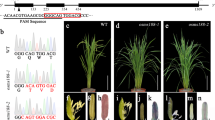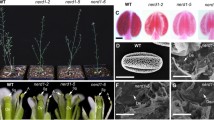Abstract
The Arabidopsis AtMYB103 gene is required for anther development, but whether the homologous gene in rice has the same role is unclear. Sequence analysis indicated that the rice OsMYB103 gene shares a high sequence similarity with AtMYB103. Therefore, we investigated the functional role of OsMYB103 in anther development using an RNAi approach. The OsMYB103 RNA transcript was expressed most abundantly in flowers, specifically in the tapetum, premeiotic pollen mother cells, and meiotic PMCs. OsMYB103-RNAi transgenic lines grew normally during their vegetative phase but displayed reduced male fertility, a phenotype that was associated with downregulated OsMYB103 transcript levels. Expression of OsMS2, an ortholog of the Arabidopsis AtMS2 gene, was also dramatically reduced in the transgenic plants. Knockdown of OsMYB103 led to defects in tapetum development, and most of the microspores in mature anthers lacked exines. Moreover, OsMYB103 could partially rescue the male sterility phenotype of an AtMYB103 knockout mutant ms188. Taken together, these results indicate that OsMYB103 does have an important role in rice tapetum and microspore development.
Similar content being viewed by others
References
Pacini E, Franchi G G, Hesse M. The tapetum: Its form, function, and possible phylogeny in Embryophyta. Plant Syst Evol, 1985, 149: 155–185
Shivanna K R, Cresti M, Ciampolini F. Pollen development and pollen-pistil interaction. In: Shivanna K R, Sawhney V K, eds. Pollen Biotechnology for Crop Production and Improvement. Cambridge, UK: Cambridge University Press, 1997. 15–39
Goldberg R B, Beals T P, Sanders P M. Anther development: Basic principles and practical applications. Plant Cell, 1993, 5: 1217–1229
Zhao D Z, Wang G F, Speal B, et al. The EXCESS MICR-OSPOROCYTES1 gene encodes a putative leucine-rich repeat receptor protein kinase that controls somatic and reproductive cell fates in the Arabidopsis anther. Genes Dev, 2002, 16: 2021–2031
Canales C, Bhatt A M, Scott R, et al. EXS, a putative LRR receptor kinase, regulates male germline cell number and tapetal identity and promotes seed development in Arabidopsis. Curr Biol, 2002, 12: 1718–1727
Yang S L, Xie L F, Mao H Z, et al. TAPETUM DETERMINANT1 is required for cell specialization in the Arabidopsis anther. Plant Cell, 2003, 15: 2792–2804
Albrecht C, Russinova E, Hecht V, et al. The Arabidopsis thaliana SOMATIC EMBRYOGENESIS RECEPTOR-LIKE KINASES1 and 2 control male sporogenesis. Plant Cell, 2005, 17: 3337–3349
Colcombet J, Boisson-Dernier A, Ros-Palau R, et al. Arabidopsis SOMATIC EMBRYOGENESIS RECEPTOR KINASES1 and 2 are essential for tapetum development and microspore maturation. Plant Cell, 2005, 17: 3350–3361
Zhang W, Sun Y, Timofejeva L, et al. Control of Arabidopsis tapetum development by DYSFUNCTIONAL TAPETUM1 (DYT1) encoding a putative bHLH transcription factor. Development, 2006, 133: 3085–3095
Sorensen A M, Kröber S, Unte U S, et al. The Arabidopsis ABORTED MICROSPORES (AMS) gene encodes a MYC class transcription factor. Plant J, 2003, 33: 413–423
Wilson Z A, Morroll S M, Dawson J, et al. The Arabidopsis MALE STERILITY1 (MS1) gene is a transcriptional regulator of male gametogenesis, with homology to the PHD finger family of transcription factors. Plant J, 2001, 28: 27–39
Zhang Z B, Zhu J, Gao J F, et al. Transcription factor AtMYB103 is required for anther development by regulating tapetum development, callose dissolution and exine formation in Arabidopsis. Plant J, 2007, 52: 528–538
Zhu J, Chen H, Li H, et al. Defective in Tapetal Development and Function1 is essential for anther development and tapetal function for microspore maturation in Arabidopsis. Plant J, 2008, 55: 266–277
Huang J F, Yang J J, Wang G, et al. Prediction of anther-expressed gene regulation in Arabidopsis. Chinese Sci Bull, 2008, 53: 3198–3203
Aarts M G, Dirkse W G, Stiekema W J, et al. Transposon tagging of a male sterility gene in Arabidopsis. Nature, 1993, 63: 715–717
Aarts M G, Hodge R, Kalantidis K, et al. The Arabidopsis MALE STERILITY2 protein shares similarity with reductases in elongation/condensation complexes. Plant J, 1997, 12: 615–623
Sanders P M, Bui A Q, Weterings K, et al. Anther developmental defects in Arabidopsis thaliana male-sterile mutants. Sex Plant Re prod, 1999, 11: 297–322
Chaubal R, Anderson J R, Trimnell M R, et al. The transformation of anthers in the msca1 mutant of maize. Planta, 2003, 216: 778–788
Nonomura K I, Miyoshi K, Eiguchi M, et al. The MULTIPLE SPOROCYTE1 (MSP1) gene is necessary to restrict the number of cells entering into male and female sporogenesis and to initiate anther wall formation in rice. Plant Cell, 2003, 15: 1728–1739
Jung K H, Han M J, Lee Y S, et al. Rice UNDEVELOPED TAPETUM1 is major regulator of early tapetum development. Plant Cell, 2005, 17: 2705–2722
Li N, Zhang D S, Liu H S, et al. The rice TAPETUM DEGENERATION RETARDATION gene is required for tapetum degradation and anther development. Plant Cell, 2006, 18: 2999–3014
Hiei Y, Ohta S, Komari T, et al. Efficient transformation of rice (Oryza sativa L.) mediated by Agrobacterium and sequence analysis of the boundaries of the T-DNA. Plant J, 1994, 6: 271–282
Murray M G, Thompson W F. Rapid isolation of high molecular weight plant DNA. Nucleic Acids Res, 1980, 8: 4321–4325
Estelle M A, Somerville C R. Auxin-resistant mutants of Arabidopsis thaliana with an altered morphology. Mol Gen Genet, 1987, 206: 200–206
Jefferson R A, Burgess S M, Hirsh D. beta-Glucuronidase from Escherichia coli as a gene-fusion marker. Proc Natl Acad Sci USA, 1986, 83: 8447–8451
Ding Z J, Wu X H, Wang T. The rice tapetum specific gene RA39 encodes a type I ribosome-inactivating protein. Sex Plant Reprod, 2002, 15: 205–212
Clough S J, Bent A F. Floral dip: A simplified method for Agrobacterium-mediated transformation of Arabidopsis thaliana. Plant J, 1998, 16: 735–743
Higginson T, Li S F, Parish R W. AtMYB103 regulates tapetum and trichome development in Arabidopsis thaliana. Plant J, 2003, 35: 177–192
Li S F, Higginson T, Parish R W. A novel MYB-related gene from Arabidopsis thaliana expressed in development anthers. Plant Cell Physiol, 1999, 40: 343–347
Fang Z J, Shi Q L, Yang Z N, et al. Functional analysis of rice OsMS2 gene involved in anther development. Chinese Bull Bot, 2008, 25: 665–672
Alexander M P. Differential staining of aborted and non aborted pollen. Stain Technol, 1969, 44: 117–122
Feng J H, Lu Y Y, Liu X D, et al. Pollen development and its stages in rice (Oryza sativa L). Chinese J Rice Sci, 2001, 15: 21–28
Steer M W. Differentiation of the tapetum in Avena. I. The cell surface. J Cell Sci, 1977, 25: 125–138
Ogata, K, Morikawa, S, Nakamura, H, et al. Comparison of the free and DNA-complexed forms of the DNA-binding domain of c-MYB. Nat Struct Biol, 1995, 2: 309–320
Kranz H D, Denekamp M, Greco R, et al. Towards functional characterization of the members of the R2R32-MYB gene family from Arabidopsis thaliana. Plant J, 1998, 16: 263–276
Jin H, Martin C. Multifunctionality and diversity within the plant MYB-gene family. Plant Mol Biol, 1999, 41: 577–585
Raghavan V. mRNAs and a cloned histone gene are differentially expressed during anther and pollen development in rice (Oryza sativa L.). J Cell Sci, 1989, 92: 217–229
Stevens V A, Murray B G. Studies on heteromorphic self-incompatibility systems: The cytochemistry and ultrastructure of the tapetum of Primula obconica. J Cell Sci, 1981, 50: 419–431
Author information
Authors and Affiliations
Corresponding author
Additional information
These authors contributed equally to this work
About this article
Cite this article
Zhang, S., Fang, Z., Zhu, J. et al. OsMYB103 is required for rice anther development by regulating tapetum development and exine formation. Chin. Sci. Bull. 55, 3288–3297 (2010). https://doi.org/10.1007/s11434-010-4087-2
Received:
Accepted:
Published:
Issue Date:
DOI: https://doi.org/10.1007/s11434-010-4087-2




